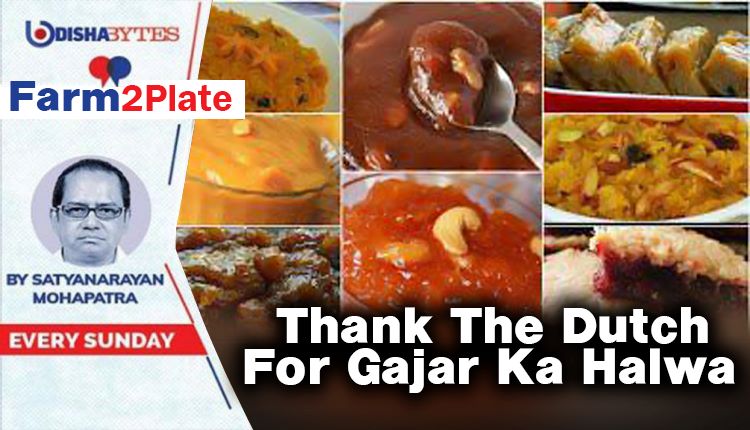Thank The Dutch For Gajar Ka Halwa

Who would think that we have to thank the Dutch for the called wonder gajar ka halwa.
It’s a tenuous connection, but orange carrots were created in the 17th century, when Dutch farmers decided to pay tribute to William of Orange. Carrots soon found their way to Punjab through Afghanistan and the rest, as they say, is history.
During the 17th century, Dutch growers cultivated orange carrots as a tribute to William of Orange – who led the struggle for Dutch independence – and the colour stuck and continuity is on. Carrots soon found their way to Punjab through Afghanistan and the rest as Gajar ka halwa is in our culinary DNA.
Gajar ka halwa is one of the most popular desserts in north Indian homes, especially in Delhi where my academic journey began. This sweet dish is popular across all sections of society. The three main inexpensive ingredients used in this dish are easy to find. The halwa itself is a perfectly warm dessert for Delhi’s frigid winters. The women folk in the family are in charge of cooking the gajar ka halwa for hours on stoves, waiting for the grated carrot to cook while the milk is reduced to less than half its quantity. The new generation uses khoya instead of milk.
The orange gajar ka halwa isn’t the only variety available. There’s a white version which is available at a century-old shop in Old Delhi called Sheeren Bhawan. Made from white carrots mainly sourced from Ghaziabad, this version is available only from mid-December to mid-February. The grated white carrots do not shrink and are slightly less sweet – giving the halwa a slightly delicate look and taste.
Lucknow, the city of great food, serves another version, which is as tasty and, again, less sweet. But the black carrot halwa isn’t popular in the sweet shops of Delhi.
This variant is less grainy and earthier, and gives a tweak to the gajar ka halwa. The grated black carrots are cooked with milk sugar, and ghee – no khoya. This creates a deep purple dessert very popular among those who prefer less sugar and more flavour.
Halwa is extremely common in north India and sometimes in the south, but is cooked less frequently in east or west India. Although Bengal has a cholar dal halwa, I am yet to see and taste it, thus reserving my comment on the same.
Food historian KT Achaya mentions in ‘The Illustrated Foods of India’ that the halwa connotes soft firm desserts made from a range of materials like wheat flour, wheat grits, vermicelli, Bengal gram flour, fruits like banana and date, nuts like almonds, and vegetables like pumpkins and dates. Not all chefs in India go by this definition.
There are some non-vegetarian variants too, such as gosht halwa and ande ka halwa which are worth mentioning. The gosht halwa is a translucent, succulent dessert soaked in ghee and cooked with tender lamb mince. The recipe is found in Old Persian recipe books, and all khansamas have their own version and recreate the dish from memory, churning out a delightful dessert prepared by cooking the meat for hours while stirring it with milk and sugar until it amalgamates into a thick halwa which is then flavoured with saffron and cardamom. This preparation traces its route to Rampur, Uttar Pradesh.
Ande ka halwa, or egg halwa, is made by cracking eggs into a pan with ghee, milk, sugar, and dried fruits. The mixture is cooked until a thick custard forms, which is then sprinkled with saffron.
Most Indian halwas, however, use grains such as suji halwa and atta halwa. For example, in Gujarat, you get the mohanlal, a halwa made of besan or chickpea flour. Like many desserts, it is very common to serve halwa during celebrations or rituals. Kada prasad is a wheat halwa which the Sikh community serves at baptisms, marriages and cremations. The jauzi halwa of Lucknow is made with almonds, milk and saffron, and is supposed to help build immunity. In Karnataka, kesari bhat is prepared by cooking wheat semolina or suji in ghee, and then with saffron and sugar.
The Sindhi community’s Karachi halwa is a chewy halwa which looks more like gelatinous fudge than halwa. Following the Partition, many renamed it Bombay halwa, primarily because Bombay (now Mumbai) and Karachi had flourished as twin port cities, and most migrants from Karachi settled in Bombay. In Delhi, however, the halwa kept being referred to as Karachi halwa and remains extremely popular as a gift because of its long shelf life. In fact, there’s a bureaucratic tradition of the Indian Finance minister preparing and offering halwa to ministry colleagues before presenting the Union budget.
The word ‘halwa’ comes from the Arabic word ‘hulw’, which means sweet. The 13th-century Arabic text Kitab al-Tabikh, written by Muhammad ibn al-Hasan Ibn al-Karim — who had compiled a recipe book of Arabic dishes — is the first known text to mention halwa. The text mentions eight different varieties of halwa along with each of their recipes. The Ain-i-Akbari, written in the 16th century by Akbar’s court historian Abul Fazl, mentions halwa as one of the dishes prepared for Akbar as part of the repertoire of dishes served during safiyana – the days during which Akbar abstained from meat.
The origins of halwa can be traced back to Arabia and came to India via Persia. There is no exact period when the halwa entered the Indian kitchen. Some are of the opinion it arrived in India during the Delhi Sultanate and gained popularity – early 13th to mid-16th century. Nimatnama, a medieval cookbook written for the Sultan of Malwa in 1500, mentions the halwa and its recipe.
Forget about the origin, it is fair to say that halwa is one of the most versatile of Indian desserts and has its own unique style to the regions to which it belongs.

Comments are closed.